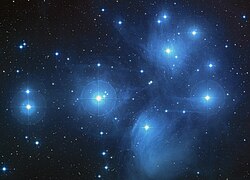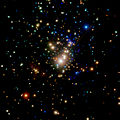Star cluster
A star cluster is a group of stars. They are held together by mutual gravitation. They are related by common origin, and have similar or identical ages.[1]
In contrast, constellations and asterisms are just line-of-sight visual groups as seen from the Earth.
There are two major types of clusters:
- open star clusters. Open clusters are loose, and they have less than a few hundred stars, which are often very young. A famous star cluster is the Pleiades, which is an open cluster.
- globular clusters. Globular clusters are tight groups of hundreds and thousands of stars. Every large galaxy has hundreds or thousands of globulars revolving round it at great distances, usually outside the disk of the galaxy.
Star clusters visible to the naked eye include the Pleiades, the Hyades, and 47 Tucanae.
Super star clusters
Super star clusters of very young large stars are known. They are thought to be precursors of globular clusters.[2] The short-lived huge blue stars emit lots of UV radiation which ionises the surrounding gas. In our galaxy, examples are Westerlund 1 and Westerlund 2 in the Milky Way. In Andromeda there is an even bigger one: Mayall II, nicknamed Globular One, has a greater luminosity than any other known globular cluster in the Local Group of galaxies.
Star Cluster Media
Messier 44, a cluster in the constellation of Cancer
The Pleiades, an open cluster dominated by hot blue stars surrounded by reflection nebulosity
The globular cluster Messier 15 photographed by HST
Messier 68, a loose globular cluster whose constituent stars span a volume of space more than a hundred light-years across
Artist's impression of an exoplanet orbiting a star in the cluster Messier 67
Scutum Star Cloud with open cluster Messier 11 at lower left
References
- ↑ "star cluster (astronomy) -- Britannica Online Encyclopedia". britannica.com. Retrieved 7 April 2010.
- ↑ Gallagher & Grebel (2002). "Extragalactic star clusters: speculations on the future". Extragalactic Star Clusters, IAU Symposium. 207: 207. arXiv:astro-ph/0109052. Bibcode:2002IAUS..207..745G.
| Wikimedia Commons has media related to Lua error in Module:Commons_link at line 62: attempt to index field 'wikibase' (a nil value).. |







